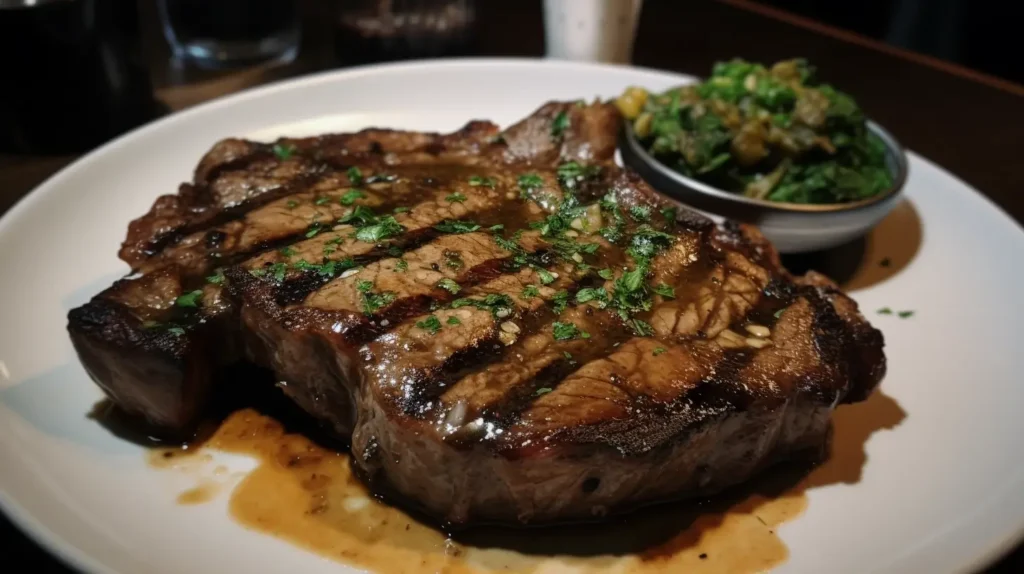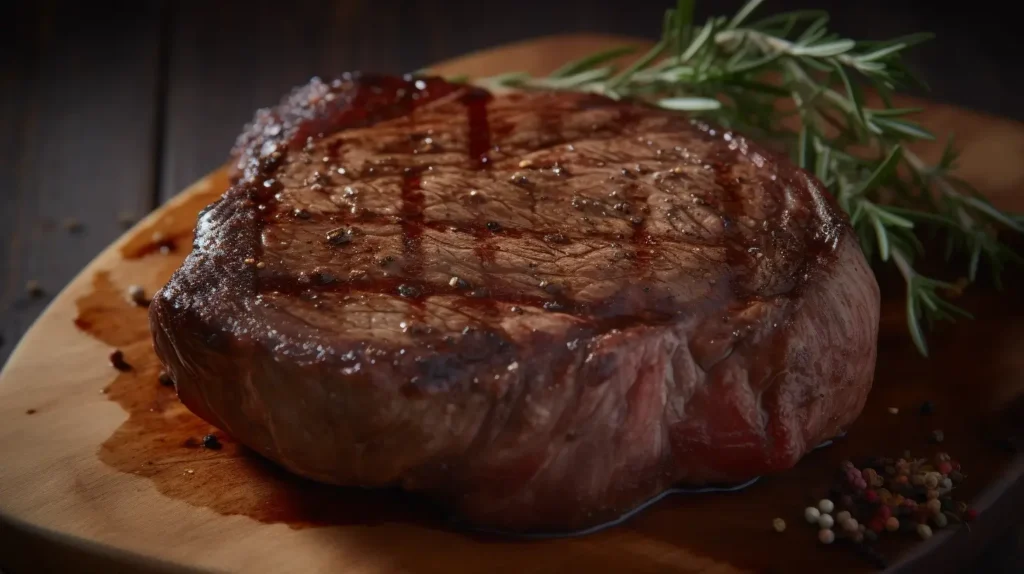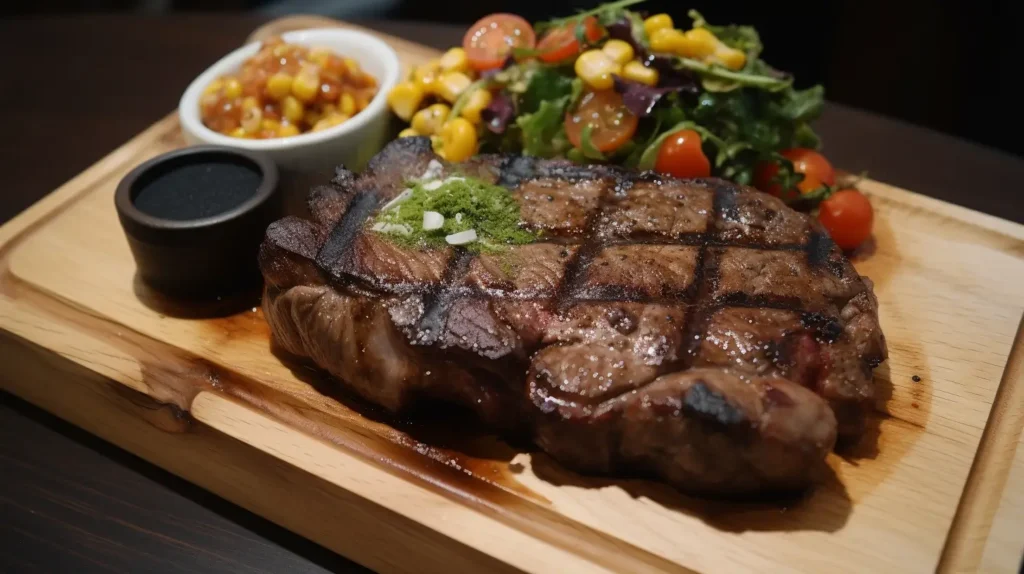Table of Contents
Cowboy Steak: The Ultimate Bone-In Ribeye Guide

If you want a thick, flavorful steak with an eye-catching presentation, this bone-in ribeye is an excellent option. Known for its juicy texture and rich marbling, it’s a top choice for grilling and a standout on special occasions.
Since it is thicker than a standard ribeye, it’s important to follow a steak cooking chart to achieve the perfect doneness. Cooking thick steaks without proper timing can lead to overcooking the exterior while leaving the inside undercooked. If you’re interested in comparing cuts, check out this Chuck Eye Steak Guide to see how cowboy steak differs from other budget-friendly ribeye alternatives.
What Is Cowboy Steak?
A bone-in ribeye from the rib primal section of the cow, this cut is known for its thicker size, making it excellent for grilling or reverse-searing. The exposed frenched bone not only enhances its distinct appearance but also helps retain heat, keeping the meat juicy and flavorful throughout cooking.
Key Characteristics:
- Typically 2-3 inches thick, making it thicker than standard ribeye cuts
- Bone-in structure enhances heat retention and depth of flavor
- Rich marbling, which adds to its tender texture
- Works well with grilling, pan-searing, or reverse-searing techniques
Because of its thicker size, this steak benefits from specific cooking techniques to achieve even doneness while ensuring the exterior is perfectly seared.
How to Select the Best Cowboy Steak
Selecting a high-quality cut is essential for achieving great flavor and tenderness. As a bone-in ribeye, choosing the right steak ensures a juicy, flavorful bite with the best texture.
What to Look for in Cowboy Steak:
- Marbling – Look for fine streaks of fat throughout the meat. More marbling means a juicier, more flavorful steak.
- Thickness – A good cowboy steak should be at least 2 inches thick, which allows for a proper sear without overcooking the center.
- Color – Fresh cowboy steak should have a bright red color and firm texture.
- Bone Exposure – The bone should be frenched (cleaned and exposed) to give the steak its classic appearance.
Where to Buy Cowboy Steak:
- Butcher Shops – Offer higher-quality cuts and better trimming.
- Online Meat Suppliers – Provide premium cuts with nationwide delivery.
- Supermarkets – Availability varies, and steaks may not always be properly trimmed.
Choosing a thick, well-marbled cut enhances the grilling or searing process, allowing for a perfectly cooked steak with rich flavor and a tender texture.
How to Slice and Serve Cowboy Steak
Once the steak reaches the desired doneness, slicing it correctly is essential for tenderness and presentation. Cutting against the grain helps retain its natural juiciness for the best texture.
Steps to Slice Cowboy Steak Correctly:
- Rest the Steak – Let the steak rest for 10 minutes after cooking. This step allows juices to redistribute evenly, keeping the meat tender.
- Locate the Grain – Look at the direction of the muscle fibers in the steak.
- Slice Against the Grain – Use a sharp knife to cut thin slices across the muscle fibers. This shortens the muscle fibers, resulting in a more tender bite.
- Angle the Cuts – Cutting at a slight 45-degree angle enhances the visual appeal of the steak.
Best Ways to Serve Cowboy Steak:
- On a Wooden Cutting Board – Creates a rustic, steakhouse-style presentation.
- With a Butter Topping – A garlic herb butter adds extra richness.
- Sliced for Sharing – Works well for group dining and family meals.
By slicing cowboy steak the right way, you get a more enjoyable, melt-in-your-mouth texture.
Cowboy Steak vs. Tomahawk Steak: Which One Should You Choose?
Both cowboy and tomahawk steak come from the ribeye section, but they have key differences in presentation, bone length, and cooking techniques.
Key Differences:
| Feature | Cowboy Steak | Tomahawk Steak |
|---|---|---|
| Bone Length | Shorter (2-3 inches) | Longer (5-7 inches) |
| Thickness | 2-3 inches | 2-3 inches |
| Cooking Method | Grilling, Reverse-Searing | Grilling, Smoking |
| Presentation | More compact, easier to cook | Dramatic look with long bone |
Which Steak Should You Choose?
- Choose cowboy steak if you want a bone-in ribeye that’s easier to handle and cook.
- Choose tomahawk steak if you prefer a larger, eye-catching cut for special occasions.
Both steaks offer great flavor, but this cut is easier to handle, making it a more practical choice for home cooking and everyday grilling
How to Cook Cowboy Steak for Maximum Flavor

Cooking cowboy steak requires high heat for a perfect sear and indirect heat for even doneness.
🔥 Grilling Cowboy Steak
- Preheat the grill to 450-500°F.
- Season generously with salt, black pepper, and garlic powder.
- Sear over direct heat for 3-4 minutes per side.
- Move to indirect heat and continue cooking until desired doneness.
🍳 Pan-Searing Cowboy Steak
- Use a cast iron skillet for even heat distribution.
- Heat avocado or canola oil until smoking hot.
- Sear for 4-5 minutes per side to develop a golden crust.
- Finish in a 375°F oven until the internal temperature reaches 130-135°F (medium-rare).
🔥 Reverse-Searing Cowboy Steak
- Preheat the oven to 225°F and cook the steak until 10-15°F below the desired temperature.
- Transfer to a hot cast iron skillet and sear each side for 90 seconds.
- Let the steak rest for 10 minutes before slicing.
Cowboy Steak Cooking Chart
Using a steak cooking chart helps ensure the right doneness:
| Doneness | Internal Temperature | Cooking Time Per Side (1.5-inch Steak) |
|---|---|---|
| Rare | 120-130°F (49-54°C) | 3-4 minutes |
| Medium-Rare | 130-135°F (54-57°C) | 4-5 minutes |
| Medium | 135-145°F (57-63°C) | 5-6 minutes |
| Medium-Well | 145-155°F (63-68°C) | 6-7 minutes |
| Well-Done | 155°F+ (68°C+) | 7-9 minutes |
For best results, allow the steak to rest for at least 5-10 minutes before cutting.
Best Side Dishes for Cowboy Steak
Pairing cowboy steak with the right sides can enhance the meal.
- Parmesan Garlic Chicken Pasta – A creamy, cheesy dish that complements the steak’s richness.
- Grilled asparagus or roasted Brussels sprouts – Adds a fresh contrast to the bold steak flavors.
- Organic Ramen Noodles – A unique twist on steak pairings for those who enjoy fusion flavors.
Why Cowboy Steak Is a Great Cut for Special Occasions
For a special dinner or celebration, this thick, bone-in cut is an excellent choice. Its bold flavor and striking presentation make it a standout centerpiece for any meal.
Reasons to Choose Cowboy Steak for Special Occasions:
- Premium Quality – As a bone-in ribeye, it offers rich marbling and tenderness.
- Impressive Presentation – The frenched bone adds a steakhouse-style appeal.
- Great for Grilling – Perfect for outdoor BBQs, family gatherings, or holiday feasts.
- consider serving it with a dark berry juice reduction or a non-alcoholic aged balsamic glaze.
Occasions Perfect for Cowboy Steak:
- Father’s Day BBQs
- Anniversary Dinners
- Holiday Feasts
- Steakhouse-Themed Gatherings
Serving cowboy steak at special events guarantees a memorable, flavorful experience for guests.
Nutritional Value of Cowboy Steak
This bone-in ribeye is not only full of flavor but also a great source of essential nutrients. It delivers high-quality protein, healthy fats, and key vitamins and minerals that support overall well-being.
Key Nutrients in Cowboy Steak:
- Protein – With around 25g per 3-ounce serving, it supports muscle growth and repair.
- Iron – Essential for red blood cell production and oxygen transport.
- Zinc – Helps strengthen the immune system and promotes healing.
- B Vitamins – Supports energy production and brain function.
Although this cut contains saturated fat, enjoying it in moderation as part of a balanced diet can help support muscle growth, strengthen immunity, and provide lasting energy. Serving it with fiber-rich vegetables creates a nutrient-packed, satisfying meal.
How Cowboy Steak Supports Muscle Growth
This protein-rich cut is a great option for those aiming to build muscle and support recovery after workouts. Since protein plays a key role in muscle repair, enjoying lean, high-protein steaks can help strengthen and rebuild muscle fibers.
Why Cowboy Steak Is Great for Muscle Growth:
- Complete Protein Source – Contains all nine essential amino acids.
- High Creatine Content – Naturally improves muscle performance and energy levels.
- Rich in Iron and B12 – Supports oxygen delivery to muscles, aiding in faster recovery.
To get the best results, enjoy this hearty cut with complex carbohydrates like sweet potatoes or whole grains, which help maintain energy levels during workouts. Cooking it with minimal added fat and pairing it with nutrient-rich vegetables creates a balanced meal that supports muscle recovery and overall well-being.
Cowboy Steak and Its Role in Energy Production
The key nutrients in this cut support energy metabolism, helping the body efficiently convert food into fuel for sustained energy throughout the day.
How Cowboy Steak Boosts Energy:
- Iron and B Vitamins – Support oxygen transport and red blood cell formation, preventing fatigue.
- Healthy Fats – Provide sustained energy for longer periods.
- High Protein Content – Prevents muscle loss and promotes endurance.
Rich in B vitamins like B6 and B12, this cut supports the body’s ability to convert carbohydrates and fats into energy. It’s a great option for those with active lifestyles, providing long-lasting fuel throughout the day. Serving it with leafy greens and whole grains can further enhance its energy-boosting properties.
Tips for Achieving the Perfect Sear
Getting the right sear is key to enhancing both flavor and texture. A proper crust locks in juiciness while adding a rich, caramelized outer layer. To achieve the best results, start by bringing the meat to room temperature before cooking. This step ensures even cooking and helps develop a deep, golden-brown crust.
Using a cast iron skillet or a high-heat grill is recommended for creating the perfect sear. Heat the cooking surface until it is very hot, then use an oil with a high smoke point, such as avocado or canola oil, to prevent burning. Once the meat is placed on the surface, avoid moving it for the first 3-4 minutes to allow the crust to form. For added flavor, basting with butter, garlic, and herbs at the last minute enhances the richness and brings out deeper savory notes.
Tips for Achieving the Perfect Sear
Getting the right sear is key to enhancing both flavor and texture. A proper crust locks in juiciness while adding a rich, caramelized outer layer. To achieve the best results, start by bringing the meat to room temperature before cooking. This step ensures even cooking and helps develop a deep, golden-brown crust.
Using a cast iron skillet or a high-heat grill is recommended for creating the perfect sear. Heat the cooking surface until it is very hot, then use an oil with a high smoke point, such as avocado or canola oil, to prevent burning. Once the meat is placed on the surface, avoid moving it for the first 3-4 minutes to allow the crust to form. For added flavor, basting with butter, garlic, and herbs at the last minute enhances the richness and brings out deeper savory notes.

FAQs:
What Cut of Meat Is Cowboy Steak?
This bone-in ribeye comes from the rib primal section of the cow and features a frenched bone, which gives it a distinctive appearance. With rich marbling, this cut is known for its tender texture and bold flavor.
As a thicker variation of a bone-in ribeye, it delivers a juicy, buttery bite when prepared correctly. Typically 2-3 inches thick, it is well-suited for grilling, pan-searing, or reverse-searing. The bone helps retain heat, keeping the meat moist and flavorful throughout the cooking process.
Due to its exceptional quality, this cut is highly favored by steak enthusiasts and chefs. Its deep, beefy taste and steakhouse-style appeal make it a top choice for special occasions and a standout on any premium steak menu.
What’s the Best Way to Cook Cowboy Steak?
Grilling and reverse-searing are excellent ways to cook this thick cut. It responds well to high heat for a rich sear, followed by indirect heat to ensure even cooking.
Is Cowboy Steak the Same as Tomahawk?
No, these two cuts are not the same, though both come from the rib section of the cow. The key difference is the bone length:
| Feature | Cowboy Steak | Tomahawk Steak |
|---|---|---|
| Bone Length | Short (2-3 inches) | Long (5-7 inches) |
| Thickness | 2-3 inches | 2-3 inches |
| Cooking Method | Grilling, Reverse-Searing | Grilling, Smoking |
| Presentation | More compact, easier to cook | Dramatic, oversized look |
Both cuts offer excellent marbling and bold flavor, but the tomahawk steak features a longer bone, giving it a dramatic appearance. Meanwhile, the cowboy steak is easier to cook and handle, making it a more convenient choice for home cooking.
Why Is Cowboy Steak So Expensive?
This cut is regarded as a high-end steak option, contributing to its higher price compared to standard cuts. Several factors influence its premium cost:
- Sourced from the Ribeye Section – Known for its tender texture and rich marbling, making it one of the most prized beef cuts.
- Bone-In Presentation – The frenched bone enhances its visual appeal, making it a favorite in steakhouses.
- Thicker Cut – At 2-3 inches thick, it requires precise butchering, which increases processing costs.
- Limited Availability – Only a few of these steaks come from each cow, making them less common than boneless ribeye, driving up demand.
With its high quality and substantial size, this cut is a top choice for those who enjoy a rich, flavorful steakhouse experience. Its bold taste and premium appeal make it a worthy investment for steak lovers.
Final Thoughts
This thick, bone-in cut delivers a bold flavor and is ideal for grilling, pan-searing, or reverse-searing. With its rich marbling and impressive presentation, it stands out as a top choice for steak enthusiasts.
By following the right cooking methods, seasonings, and temperature guidelines, you can achieve a steakhouse-quality result in your kitchen.